
Original Link: https://www.anandtech.com/show/1474
Socket 754 Roundup, Part 3: Asus, Soltek & DFI
by Wesley Fink on September 14, 2004 12:03 AM EST- Posted in
- Motherboards
Index
This is our third roundup of Athlon 64 Socket 754 motherboards. Our first roundup appeared last fall in Athlon64 Motherboards: First Look at Chaintech, FIC, and MSI. Several individual boards were reviewed after that, and then we did a roundup of the second generation 754 boards this past May in Socket 754 Roundup: Comparing Generation 2. This was just before the introduction of Socket 939, and we really thought that this would be the last review of major boards for Socket 754. It was expected that when the dual-channel Socket 939 was introduced in June, the only new 754 boards would be aimed at the value market. However, several factors have changed those expectations.First, the second generation 754 chipsets for Athlon 64 represented a genuine improvement in features, flexibility, and performance for AMD's processors. Second, while we did find the 939 to be a faster processor, the real performance improvements from dual-channel memory are fairly small, mainly because the Athlon 64 uses shorter pipes and is not as bandwidth-sensitive as current Pentium 4 processors. This means that the real improvement from dual-channel 939 is only about 2% to 5%. Third, and perhaps most important, AMD has kept prices for Socket 939 very high, with all the value A64 CPUs only available in Socket 754. Fourth, enthusiasts have found that many Socket 754 boards, like the recently reviewed DFI LANParty UT nF3-250Gb, overclock those bargain processors very well - often reaching beyond the performance that can be achieved with overclocked 939 processors, which are more expensive.
All of these factors have encouraged some manufacturers to introduce new Socket 754 motherboards aimed at the enthusiast even after the Socket 939 was launched and processors were available. In this installment, we will take a closer look at the Asus K8N-E, Soltek K8AN2E-GR, and the DFI nF3-250Gb. All 3 boards are based on the second generation nVidia nForce3-250Gb chipset. As you saw in our chipset review, nVidia has added the features to bring their nF3-250 to the competitive edge of Athlon 64 chipsets. The HyperTransport speed, which was widely criticized on the 150 chipset, is now 800 or 1000 depending on the chipset version. The on-chip Gigabit LAN and on-chip Firewall are also unique and truly useful features compared to other A64 boards. nVidia also fixed the problems with their implementation of PCI/AGP lock on the 150, and we have found a working PCI/AGP lock on every nForce3-250 motherboard that we have tested, just as nVidia promised.
We have compared the 3 new motherboards to all of the boards in our second generation roundup. Since boards based on the nF3-250 family and the updated VIA K8T800 PRO offer genuine improvements over the earlier first generation boards, we have only included boards based on these second generation chipsets in this comparison. If overclocking is not particularly important to you, then one of the first generation boards based on the VIA chipset might also meet your needs at a lower price. Please keep in mind that most of the first generation boards did not have working AGP/PCI locks and HyperTransport speeds, and options were generally lower than second generation boards. Again, this probably does not matter if you never plan to overclock your Socket 754 board, but if overclocking is part of your plans, the 2nd generation boards are much more capable. As already mentioned, the feature sets are also generally better on 2nd generation motherboards for A64.
Asus K8N-E: Features and Layout
| Asus K8N-E Motherboard Specifications | |
| CPU Interface | Socket 754 Athlon 64 |
| Chipset | nVidia nForce3-250Gb |
| CPU Ratios | 4 to CPU Default in 0.5X increments |
| Bus Speeds | 200MHz to 300MHz (in 1MHz increments) |
| PCI/AGP Speeds | Auto, 66MHz to 75MHz (in 1MHz increments) |
| HyperTransport | 1x-4x (200MHz to 800MHz) in 1x |
| Core Voltage | 0.85V-1.75V in .025V increments |
| DRAM Voltage | Auto, 2.5V to 2.7V in 0.1V increments |
| AGP Voltage | 1.5V to 1.7V in 0.1V increments |
| Memory Slots | Three 184-pin DDR DIMM Slots Unbuffered Memory to 3GB Total |
| Expansion Slots | 1 AGP 8X Slot 5 PCI Slots |
| Onboard SATA/RAID | 2-drive SATA by nVidia nF3-250GB RAID 0, 1, JBOD plus Silicon Image 3114 4-Drive SATA RAID 0, 1, 10, 5, JBOD |
| Onboard IDE/RAID | Two nVidia ATA133/100/66 by nF3-250Gb (4 drives) RAID 0, 1, JBOD |
| Onboard USB 2.0/IEEE-1394 | 8 USB 2.0 ports supported by nF3-250 2 FireWire ports by VIA VT6307 |
| Onboard LAN | Gigabit Ethernet by 88E1111 PHY |
| Onboard Audio | Realtek ALC850 8-Channel With Coaxial and Optical SPDIF Out |
| BIOS | 1004 Release (8/13/2004) |
While Asus was quick to get Socket 754 boards to market based on the VIA chipset, it has taken them quite a while to bring an nForce3-250Gb board to market. This was more than a bit surprising, considering some of the excellent nForce 2 designs with an Asus name. We were more than a bit surprised, however, to find the uneven range of adjustment options on the K8N-E. Perhaps this is a concession to the K8N-E appearing late in the 754 cycle, but we were particularly dismayed by memory voltage adjustments that top out at 2.7V. This is not even adequate for some of the best-performing memory on the market when you use 2 or more DIMMs at DDR400. Some of the fastest current memory requires 2.8V with 2 DIMMs at DDR400.
The other surprise was the decision by Asus to use just 2 nVidia SATA channels, with 4 additional Silicon Image SATA connectors. While 6 SATA connections are nice, you will see in our overclocking tests that this arrangement makes serious overclocking with a SATA drive all but impossible. We have had much better success with boards that use the full nVidia "any-drive" RAID, since SATA channels 3 and 4 are usually great choices for unrestricted overclocking with SATA drives.
Fortunately, Asus did use a PHY chip to preserve fully the on-chip nVidia gigabit Ethernet. This means that your gigabit LAN is capable of running at full speed without the constraints of the PCI bus.

Asus is normally masterful in their board layouts, with careful attention to function and placement of board components. The K8N-E is typical Asus, which means that the layout is very good indeed.
IDE connectors are in our preferred upper right edge location, though Asus has placed the floppy connector on the bottom right edge of the board - a less desirable location in many case layouts. If you need to connect a floppy, make sure that you pay close attention to the location of the floppy in your case compared to the K8N-E. The 20-pin ATX connector and 4-pin 12V are almost ideal, since both are out of the way on board edges and do not need to be snaked over or around any components.
The CPU socket area is clear and can generally handle oversized HSF. Only the top edge between the CPU socket and the rear IO is a concern, with a row of capacitors and coils close to the socket. Fortunately, the capacitors are on the short side, making it likely that most big overhanging heatsinks will clear the caps.
Except for the inadequate memory voltages available, the overclocking controls are OK, if not noteworthy. The CPU voltage is wider than what we see on many competing boards, and the 200 to 300 CPU adjustments are average. Asus did not include any chipset voltage adjustments at all on the K8N-E, a feature that many will miss. Also, the HT range only extends to 4X in large 1X increments - a range to 5X like many competitors with finer 0.5X adjustments would have been useful. It was good to see Asus paying more attention to the FID/VID ratios, where finer 0.5X adjustments will be appreciated by any enthusiast.
All-in-all, the K8N-E is a really mixed bag, with some adjustments that are exemplary, and others, missing or downright crude. With the attention that Asus has lavished on their VIA-chipset Athlon 64 boards, you have to wonder what they were thinking when designing the K8N-E. As you will see in our benchmark results, this lack of consistent OC controls with broad ranges is really a shame, since the Asus K8N-E is a fast 754 board.at stock speeds.
Asus K8N-E: Overclocking and Stress Testing
FSB Overclocking Results
| Front Side Bus Overclocking Testbed | |
| Default Voltage | |
| Processor: | Athlon 64 3200+ 2.0GHz |
| CPU Voltage: | 1.5V (default) |
| Cooling: | Thermaltake Silent Boost K8 Heatsink/Fan |
| Power Supply: | OCZ Power Stream 520W |
| Memory: | OCZ PC3200 EL Platinum Rev. 2 or Geil PC3200 Ultra X |
| Maximum OC: (Standard Ratio) |
246 x 10 (IDE), 230 x 10 (SATA) 2460MHz (+23%) |
| Maximum FSB: (Lower Ratio) |
271 x 9 (1:1 Memory, IDE, 2 DIMMs) 230 x 9 at (1:1 Memory, SATA, 2 DIMMs) |
The decision by Asus to use Silicon Image SATA instead is really a drawback in overclocking. Whether using the 2 nVidia SATA channels or any of the 4 Sil3114 channels, the highest overclock that we could achieve with our standard SATA drive was 230, much lower than some other nF3-250 boards. When using an IDE drive, the K8N-E fared better, reaching a stable 271 FSB at 1:1 before failing boot. While this is a much better overclock, it is still below the performances of the DFI, MSI, Epox, and Chaintech 754 boards that we have tested.
Due to the overclock limits found with SATA drives on the Asus, we would recommend using IDE drives with the Asus if you plan to overclock. The Asus can handle reasonable overclocks with a SATA drive, and we confirmed AGP/PCI is definitely working. However, the highest overclocks could only be achieved using IDE hard drives.
Memory Stress Test Results:
The memory stress test is very basic, as it tests the ability of the Asus K8N-E to operate at its officially supported memory frequency (400MHz DDR), at the best performing memory timings that our OCZ PC3200 Platinum Rev. 2 modules will support. Memory stress testing was conducted by running RAM at 400MHz with 2 DIMM slots filled. However, please keep in mind that Socket 754 is single-channel and will still operate at top speed with just one DIMM.| Stable DDR400 Timings - 2 DIMMs (2/3 Dimms populated - Single-Channel mode) |
|
| Clock Speed: | 200MHz |
| CAS Latency: | 2.0 |
| RAS to CAS Delay: | 2T |
| RAS Precharge: | 10T* |
| Precharge Delay: | 2T |
| Command Rate: | 1T |
The Asus K8N-E was completely stable with 2 DIMMs at the best performing settings of 2-2-2-10, at default speed. Command Rate was set to Auto, but is reported as performing at 1T in SiSoft Sandra benchmarks.
Filling all three available memory slots is more strenuous on the memory sub-system than testing 2 DIMMs on a motherboard.
| Stable DDR400 Timings - 3 DIMMs (3/3 DIMMs populated - Single-Channel mode) |
|
| Clock Speed: | 200MHz |
| CAS Latency: | 2.0 |
| RAS to CAS Delay: | 2T |
| RAS Precharge: | 10T* |
| Precharge Delay: | 2T |
| Command Rate: | 2T |
We were very pleased to find that 3 DS DIMMs (1.5GB) of memory worked fine at the same aggressive timings that we used for 2 DIMMs. This is very good performance for the K8N-E in our memory stress test. However, we should point out that while the Asus was stable in most of our benchmark tests with 3 DIMMs, it was not completely stable in Quake 3 or Return to Castle Wolfenstein with 3 DIMMs. Memory voltage increases were just not an option. It appears that our fast memory really wants 2.8V with 3 DIMMs and this shows up in some games. The limited memory voltage range may well be your real limiter in overclocking with 3 DIMMs.
Soltek K8AN2E-GR: Features and Layout
| Soltek K8AN2E-GR Motherboard Specifications | |
| CPU Interface | Socket 754 Athlon 64 |
| Chipset | nVidia nForce3-250Gb |
| CPU Ratios | 4 to 20X in 1X increments |
| Bus Speeds | 200MHz to 250MHz (in 1MHz increments) |
| PCI/AGP Speeds | Auto, 66MHz to 100MHz (in 1MHz increments) |
| HyperTransport | 1x-5x (200MHz to 1GHz) |
| Core Voltage | 0.8V-1.55V in .025V increments |
| DRAM Voltage | 2.6V to 2.8V in 0.1V increments |
| AGP Voltage | 1.5V to 1.8V in 0.1V increments |
| Chipset Voltage | 1.6V to 1.9V in 0.1V increments |
| Memory Slots | Two 184-pin DDR DIMM Slots Unbuffered Memory to 2GB Total |
| Expansion Slots | 1 AGP 8X Slot 5 PCI Slots |
| Onboard SATA/RAID | nVidia 2-Drive SATA by nF3-250 RAID 0, 1, JBOD PLUS 2 SATA by Promise PDC20579 RAID 0, 1, JBOD |
| Onboard IDE/RAID | Two nVidia ATA133/100/66 by nF3-250Gb (4 drives) RAID 0, 1, JBOD plus One Promise RAID IDE (2 drives) by PDC20579 |
| Onboard USB 2.0/IEEE-1394 | 8 USB 2.0 ports supported by nF3-250 No FireWire ports |
| Onboard LAN | Gigabit Ethernet by Cicada CIS8201 PHY |
| Onboard Audio | Realtek ALC650 6-Channel with SPDIF |
| BIOS | Version 1.1 (9/02/2004) |
The Soltek is smaller than a standard ATX board. While it is clear that Soltek has designed the K8AN2E for value, like the Chaintech VNF3-250, it is interesting that Soltek decided to implement most of the unique features of the nF3-250 family by using the premium 250Gb chipset instead of the cheaper nF3-250. Vendors stocking the Soltek are selling it for less than $100, and the 250Gb brings you the nVidia on-chip LAN and Firewall/RAID capabilities of the Gb chipset.
It would have been an even better board if Soltek had fully implemented the nVidia SATA RAID capabilities, but you can see that the additional 2 SATA channels and an added IDE channel are provided by the Promise controller. Once again, this arrangement proved to limit overclocking capabilities with a SATA drive, though the board was still capable with an IDE hard drive.
The range of overclocking controls and options on the Soltek are quite good, as we have come to expect of Soltek boards. The memory voltage extends to 2.8V, better than the Asus K8N-E but still on the low side. There is also a useful range of chipset voltage adjustments missing from the Asus, and an HT range to 5X. The only puzzle here is the CPU range to just 250 with the latest BIOS. Our evaluation BIOS extended to 300, so we were surprised to see that Soltek cut the range on the latest BIOS. Frankly, 250 is not enough for an nForce3-250 board with working PCI/AGP lock, and we hope that Soltek can correct this with a new BIOS. The CPU voltage options to just 1.55V are also limited for a CPU rated at 1.5V.
All-in-all, Soltek makes fewer compromises than the Chaintech VNF3-250 in their effort to control price of the 754 board. The only real feature missing from the Soltek is IEE 1394 Firewire ports. So, if this is an important feature, look elsewhere or plan to use an accessory PCI Firewire controller. However, the Chaintech still succeeds better than almost any value 754 in the area of overclocking.
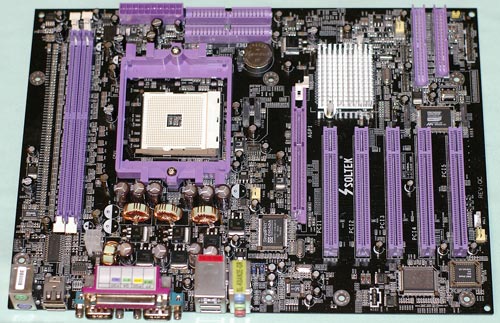
The Soltek is smaller than a full ATX size, but the layout is very good, better than you might expect in a smaller board. The main IDE connectors are located in the preferred upper right edge. The 24-pin ATX power and 4-pin 12V are both near board edges where they do not interfere with other components. The floppy location will be a concern to some with a lower right edge location, but this will not likely be a problem in the cases that are most likely to be combined with the value Soltek board. The Promise SATA and IDE connections are also located at the lower right.
Another departure from the usual for Soltek is the use of two DIMM connectors instead of the more common 3 connectors, which will be an issue to some end users. There is clearly room for 3 connectors; it even appears the board was designed for 3 dimm slots. However, Soltek uses just 2 dimm slots on the K8AN2E.
Soltek K8AN2E-GR: Overclocking and Stress Testing
FSB Overclocking Results
| Front Side Bus Overclocking Testbed | |
| Default Voltage | |
| Processor: | Athlon 64 3200+ 2.0GHz |
| CPU Voltage: | 1.5V (default) |
| Cooling: | Thermaltake Silent Boost K8 Heatsink/Fan |
| Power Supply: | OCZ Power Stream 520W |
| Memory: | OCZ PC3200 EL Platinum Rev. 2 or Geil PC3200 Ultra X |
| Maximum OC: (Standard Ratio) |
246 x 10 (IDE), 230 x 10 (SATA) 2460MHz (+23%) |
| Maximum FSB: (Lower Ratio) |
250 x 9 (1:1 Memory, IDE, 2 DIMMs) 230 x 9 at (1:1 Memory, SATA, 2 DIMMs) |
While the Soltek SL-K8AN2E-GR fared a bit better than the Asus with SATA drives, both sets of SATA connections still limited the maximum overclock. The board managed to reach a more respectable 250 CPU setting (the maximum available with the latest BIOS) with an IDE drive, but this is still far short of the 270 to 316 that we have seen with other nForce3-250 boards.
We suspect that the Soltek can do much better than 250 with lower ratios, but that is the current limit of the CPU range. If Soltek fixes this oversight with a BIOS update, you will likely be able to achieve higher performance with the K8AN2E-GR. The other controls that are needed for excellent overclocking with the Soltek are all here.
Memory Stress Test Results:
The memory stress test measures the ability of the Soltek K8AN2E-GR to operate at its officially supported memory frequency (400MHz DDR), at the best performing memory timings that our OCZ PC3200 Rev. 2 modules will support. Memory stress testing was conducted by running RAM at 400MHz with 2 DIMM slots filled. However, please keep in mind that Socket 754 is single-channel and will still operate at top speed with just one DIMM.| Stable DDR400 Timings - 2 DIMMs (2/2 DIMMs populated) |
|
| Clock Speed: | 200MHz |
| Timing Mode: | N/A |
| CAS Latency: | 2.0 |
| RAS to CAS Delay: | 2T |
| RAS Precharge: | 10T* |
| Precharge Delay: | 2T |
| Command Rate: | 1T |
The Soltek K8AN2E-GR was completely stable with 2 DIMMs at the best performing settings of 2-2-2-10, at default speed. The Soltek has just 2 DIMM slots and does not support 3 DIMMs.
DFI LANParty UT nF3 250Gb: Features and Layout
| DFI nF3 250Gb Motherboard Specifications | |
| CPU Interface | Socket 754 Athlon 64 |
| Chipset | nVidia nForce3-250Gb |
| Bus Speeds | 200MHz to 456MHz (in 1MHz increments) |
| PCI/AGP Speeds | 66MHz to 100MHz (in 1MHz increments) |
| Core Voltage | Auto, 0.8V to 1.55V in .025V increments plus Vid Special multiplier of 4%, 10%, 13%, 23%, 26%, 33%, 36% - TO 2.1V |
| DRAM Voltage | Auto, 2.5V to 3.1V in 0.1V increments (to 3.3V with future BIOS) |
| AGP Voltage | 1.5V-1.9V in 0.1V increments |
| Chipset Voltage | 1.6V-1.9V in 0.1V increments |
| Hyper Transport Ratios | Auto, 1x, 1.5 x, 2 x, 2.5 x, 3 x, 4 x, 5 x |
| CPU Ratios | Auto, 4.0x to 20.0x in 0.5X increments |
| DRAM Speeds | Auto, 100, 120, 133, 140, 150, 166, 180, 200 |
| Memory Slots | Three 184-pin DDR Single-Channel Slots Unbuffered Non-ECC Memory to 2GB Total |
| Expansion Slots | 1 AGP 8X Slot 5 PCI Slots |
| Onboard SATA | 4-Drive SATA by nF3-250Gb |
| Onboard IDE | Two Standard nVidia ATA133/100/66 (4 drives) |
| SATA/IDE RAID | 4-Drive SATA Plus 4-Drive IDE can be combined in nVidia RAID 0, 1, 0+1, JBOD |
| Onboard USB 2.0/IEEE-1394 | 8 USB 2.0 ports supported by nF3-250Gb 2 1394A FireWire ports by VIA VT6307 |
| Onboard LAN | 1 Gigabit Ethernet on-chip by nF3-250GB and Marvel PHY |
| Onboard Audio | Realtek ALC850 8-Channel with UAJ SPDIF coaxial in and out |
| BIOS | Award 8/27/2004 |
We recently did an in-depth review of the DFI in DFI LANParty UT nF3-250Gb: Overclocker's Dream. We have included the tables of features and the DFI photo for easier comparison of the 3 boards. You should refer to the review for detailed information about the DFI LANParty UT nF3-250Gb.
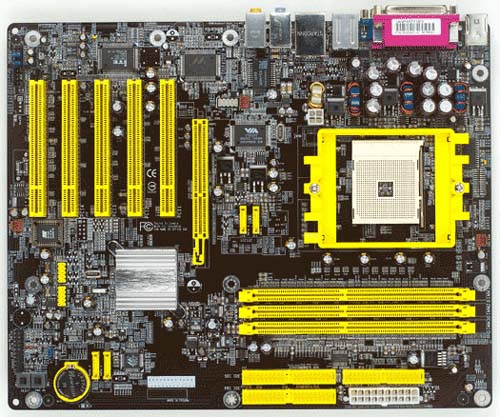
DFI LANParty UT nF3 250Gb: Overclocking and Stress Testing
FSB Overclocking Results
| Front Side Bus Overclocking Testbed | |
| Default Voltage | |
| Processor: | Athlon 64 3200+ 2.0GHz |
| CPU Voltage: | 1.5V (default) |
| Cooling: | Thermaltake Silent Boost K8 Heatsink/Fan |
| Power Supply: | OCZ Power Stream 520W |
| Memory: | OCZ PC3200 EL Platinum Rev. 2 or Geil PC3200 Ultra X |
| Maximum OC: (Standard Ratio) |
248 x 10 2470MHz (+24%) |
| Maximum FSB: (Lower Ratio) |
316 x 8 -1:1 Memory, 1 DIMM 270 x 9 at (1:1 Memory, 2 DIMMs) |
The DFI LANParty UT nF3 250Gb was recently reviewed in-depth (DFI LANParty UT nF3-250Gb: Overclocker's Dream). Overclocking and Memory Performance charts are included here for easier reference. You should refer to the DFI review for complete information on the board's performance.
Memory Stress Test Results:
| Stable DDR400 Timings - 1 DIMMs (1/3 DIMMs populated - Single-Channel mode) |
|
| Clock Speed: | 200MHz |
| CAS Latency: | 1.5 |
| RAS to CAS Delay: | 2T |
| RAS Precharge: | 10T* |
| Precharge Delay: | 2T |
| Command Rate: | 1T |
We have not tested a Socket 754 board that offered a CAS 1.5 setting. The OCZ memory ran without problems with 1 DIMM at 1.5-2-2-10 settings.
| Stable DDR400 Timings - 2 DIMMs (2/3 DIMMs populated - Single-Channel mode) |
|
| Clock Speed: | 200MHz |
| CAS Latency: | 2.0 |
| RAS to CAS Delay: | 2T |
| RAS Precharge: | 10T* |
| Precharge Delay: | 2T |
| Command Rate: | 1T |
All earlier 754 benchmarks were run with 2 DIMMs, and this is the configuration that was used for all standard benchmark tests. The DFI LANParty UL was completely stable with 2 DIMMs at the rated timings of 2-2-2-10, at default speed.
Filling all three available memory slots is more strenuous on the memory sub-system than testing 2 DIMMs on a motherboard. We were very pleased to find that 3 DS DIMMs (1.5GB) of memory worked fine at timings almost the same as the aggressive timings which we used for 2 DIMMs. The DFI is one of the few Socket 754 boards that we have tested which can handle 3 DS DIMMs. You do need to use slightly slower timings with 3 DIMMs, but the 2-2-3-10 is very close to the rated 2-2-2-10 timings of the memory that we used for testing.
| Stable DDR400 Timings - 3 DIMMs (3/3 DIMMs populated - Single-Channel mode) |
|
| Clock Speed: | 200MHz |
| CAS Latency: | 2.0 |
| RAS to CAS Delay: | 3T |
| RAS Precharge: | 10T* |
| Precharge Delay: | 2T |
| Command Rate: | 2T |
The boot screen and Sisoft Sandra 2004 both reported a Command Rate of 2T when all 3 DIMM slots were filled.
Standard Performance Test Configuration
If you are interested in more information comparing the Athlon 64, Athlon 64 FX, LGA 775 Prescott, P4, and P4EE, please see our in-depth comparisons in these recent reviews:Intel's 925X & LGA-775: Are Prescott 3.6 and PCI Express Graphics any Faster?
Intel 925X/915: Chipset Performance & DDR2
Socket 939 Chipsets: Motherboard Performance & PCI/AGP Locks
AMD Athlon 64 3800+ and FX-53: The First 939 CPUs
The Athlon 64 FX-53: AMD's Next Enthusiast Part
Intel's Pentium 4 E: Prescott Arrives with Luggage
Athlon64 3400+: Part 2
AMD's Athlon 64 3400+: Death of the FX-51
Athlon64 3000+: 64-bit at Half the Price
| Performance Test Configuration | |
| Processor(s): | AMD Athlon 64 3200+ (2.0GHz) |
| RAM: | 2 x 512MB OCZ PC3200 EL Platinum Rev.2 2 x 512MB Geil PC3200 Ultra X 2 x 512MB Mushkin PC3500 Level II or 2 x 512MB OCZ PC3500 Platinum Ltd |
| Hard Drive(s): | Maxtor 250GB 7200RPM IDE (16MB Buffer) |
| Video AGP & IDE Bus Master Drivers: | NVIDIA nForce Platform Driver 4.24 (5-10-2004) VIA 4in1 Hyperion 4.51 (12-02-2003) |
| Video Card(s): | ATI Radeon 9800 PRO 128MB (AGP 8X) |
| Video Drivers: | ATI Catalyst 4.8 |
| Operating System(s): | Windows XP Professional SP1 |
| Motherboards: | Asus K8N-E Soltek K8AN2E-GR DFI LANParty UL nF3 250Gb Abit KV8 PRO (VIA K8T800 PRO) Chaintech VNF3-250 (nVidia nForce3-250) Epox 8KDA3+ (nVidia nForce3-250Gb) Gigabyte K8NSNXP nVidia nForce3-250) MSI K8N Neo (nVidia nForce3-250Gb) nVidia nForc3-250Gb Reference Board |
Current testing of Socket 754 Athlon 64 motherboards used OCZ PC3200 EL Platinum Rev. 2 or Geil PC3200 Ultra X, which are based on Samsung TCCD memory chips. Earlier tests of Socket 754 boards used either Mushkin PC3500 Level II or OCZ PC3500 Platinum Ltd memory modules. Both these memories use Winbond BH5 chips, which have been discontinued. All benchmarks used 2-2-2-10 memory timings regardless of memory used.
Performance tests were run with the ATI 9800 PRO 128MB video card with AGP Aperture set to 128MB with Fast Writes enabled. Resolution in all benchmarks is 1024x768x32 unless otherwise noted.
General Performance and Encoding
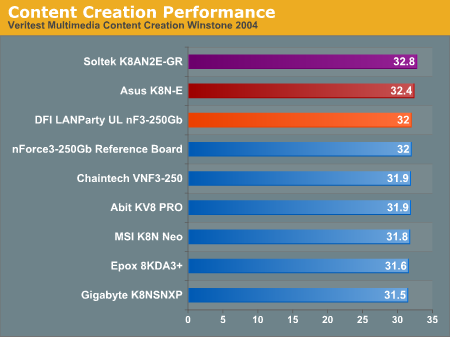
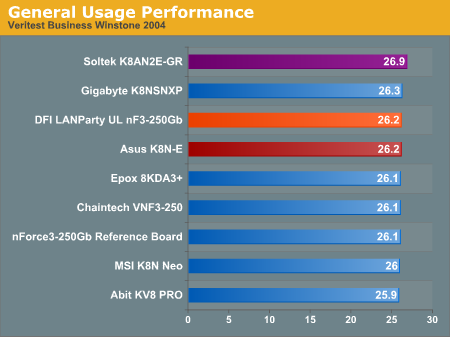
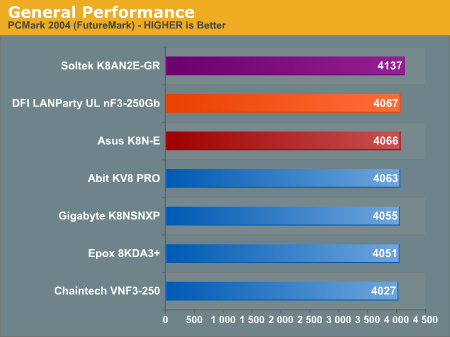
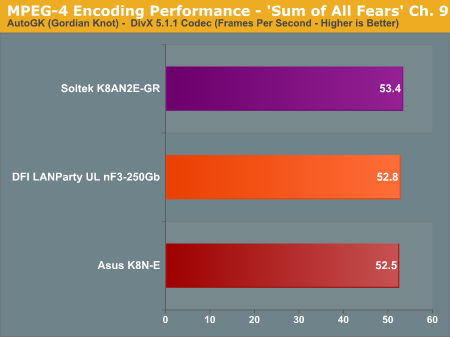
Values remain tightly clustered for 2nd generation 754 boards in Multimedia Content Creation and Business Winstone. It is interesting, however, that these most recent 754 boards are the boards at the top of the charts. It appears that Socket 754 has matured and manufacturers have learned to squeeze a bit more from the chipsets and processors.
The Soltek is a particularly fast performer at stock speeds. At a price of less than $100, it is a great value if you plan to run at stock and do not have a pressing need for on-board firewire.
The Soltek was a particular surprise in the 2-pass Media Encoding benchmark. In the past, we have seen values tightly clustered in boards using the same chipset and CPU. The Soltek even managed to top encoding by a skim margin. As we have stated in past reviews, the on-board memory controller of the Athlon 64 tends to make any differences between boards much smaller than what we have seen in the past with the memory controller on the chipset. So, variations in performance are more significant than they may first appear.
DX9 Gaming Performance

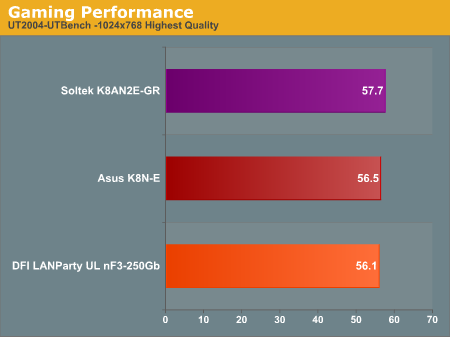
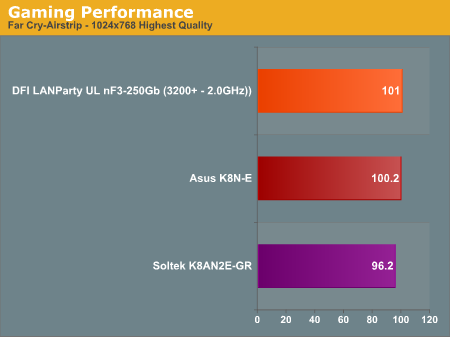
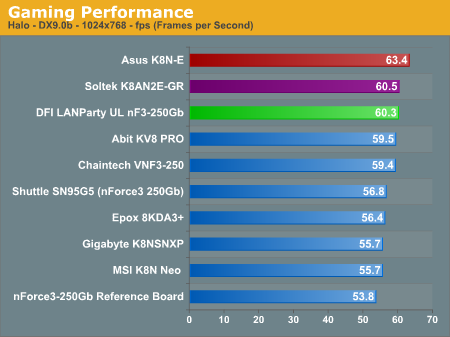
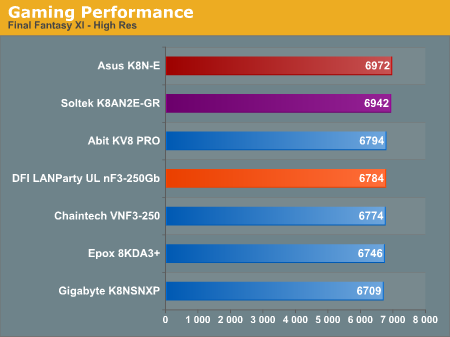
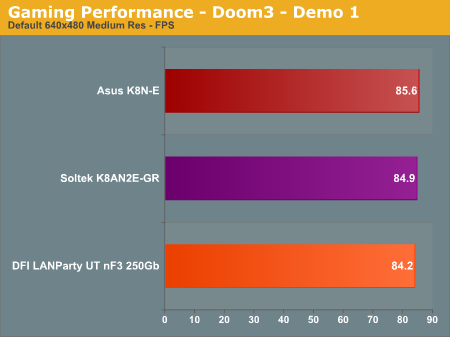

Results in DX9 Gaming are really mixed across these 3 boards. It is hard to ignore the top Asus performance in Doom 3, Aquamark 3, and Halo. However, this is tempered by top positions by the Soltek in UT2004 and DFI in Far Cry. This seems more a reflection of the optimizations that engineers used with each board, rather than a measure of comparative performance.
DX8 and OpenGL Gaming Performance

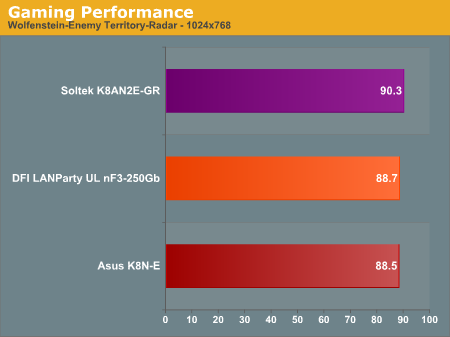
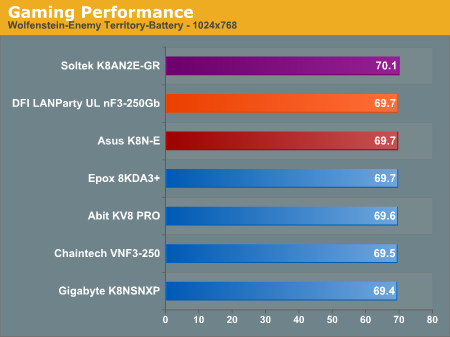
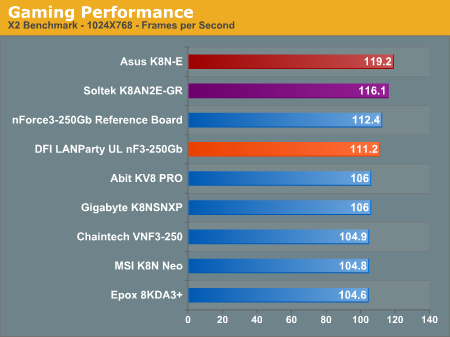

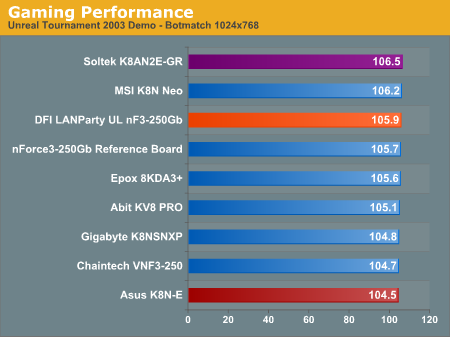
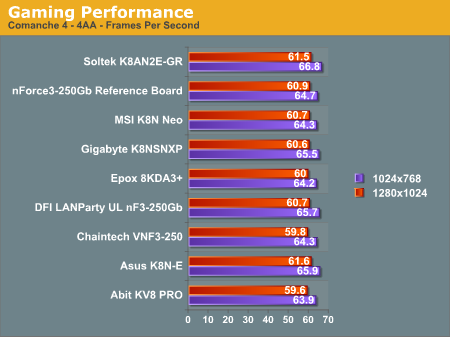
There is no clear winner in DX8 and Open GL gaming. The 3 tested boards switch positions in almost every benchmark. The Soltek continues as one of the fastest boards at stock that we have tested.
Workstation Performance
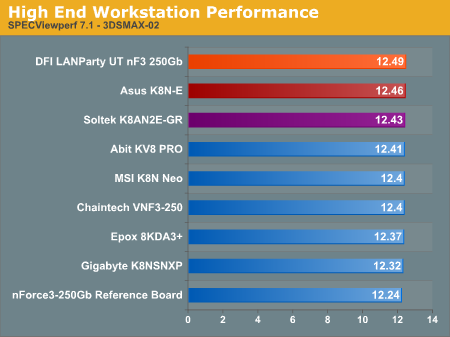
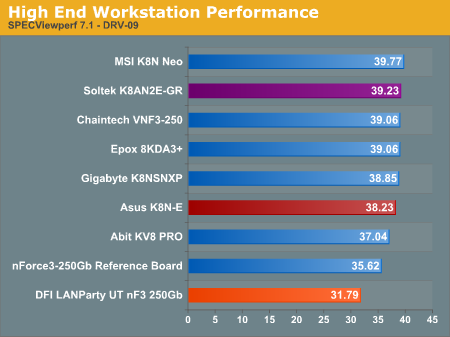
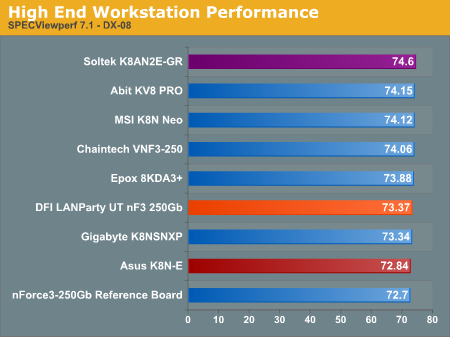
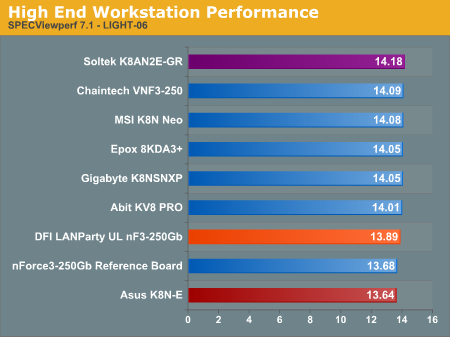
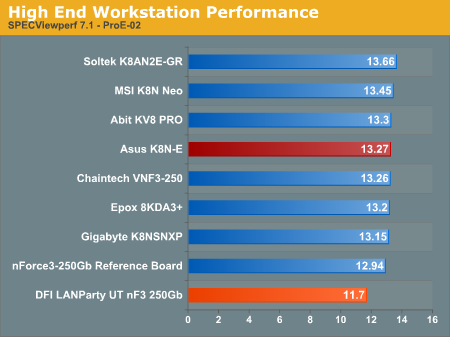
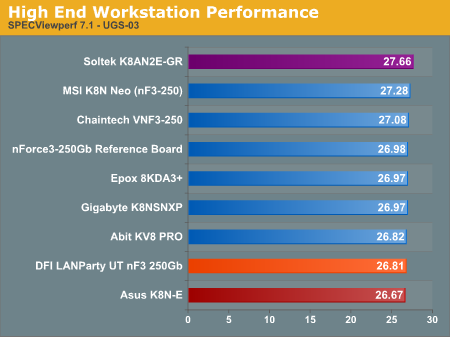
The Soltek K8AN2E-GR does very well in the SPECviewperf Suite. The DFI is particularly uneven in the workstation benchmarks, which is most likely a reflection of the tweaks that have been done to achieve the remarkable overclocking it exhibits. The Asus K8N-E falls somewhere between these extremes.
Final Words
With this round of second generation 754 boards, we are finally seeing a broader range of performance differences than what we have seen in past benchmark tests. All three of these recent boards are generally among the better performers compared to other 2nd generation 754 boards. The differences are still not huge, but they are there. The Soltek, in particular, seems to appear at or near the top in almost every benchmark. The same can be said for the Asus K8N-E, and the DFI remains one of the better overall performers in the comparison at stock speed.The message here is that if performance at stock speed is your primary criteria, then any of these three boards will do a good job for you, along with several choices from earlier testing. The Soltek, in particular, is fast at stock, and very reasonable to buy. However, when we look beyond stock performance, the picture does begin to change.
In the real world, features do matter also, and if we look more closely at the 3 boards, we do see quite a few differences. All three boards use the superior nF3-250Gb chipset that provides on-chip LAN capabilities and nVidia LAN and Firewall. All 3 also appear to use the proper PHY gigabit LAN to bypass the PCI bus on the nVidia chipset for top LAN speed. However, the Soltek and Asus do not fully implement the nVidia "any-drive" RAID, and go their own route for SATA channels beyond 2. As much as we admire Soltek's Promise controller with 2 added SATA and an additional IDE slot, we would trade it in an instant for SATA performance that would go beyond a 233 CPU setting. This is even truer for the Asus with 6 total SATA ports, none of which would work beyond 230 in our overclocking tests. In fairness, both the Soltek and Asus performed much better with IDE drives. The Asus is one of the better-performing nF3-250Gb boards that we have tested when coupled with an IDE drive. The Soltek quickly reaches the board limit of 250 with IDE, which is low, but without a higher range of CPU settings, we can only guess what the real capabilities of the K8AN2E really are.
Of the three boards tested here, the DFI is the only one that fully implements the features of the nVidia nForce3-250GB, and this shows in the ability of SATA ports 3 and 4 to perform just as well as IDE on the DFI board. While the Soltek and Asus are a bit faster, the DFI clearly wins on feature quality. The Asus has more SATA ports, but the SATA ports don't work at extended range as the DFI SATA does.
This brings us to our last criterion, overclocking performance. Here, there is just no contest at all. The DFI LANParty UT nF3 250Gb is the best overclocking Athlon 64 board that we have ever tested. In addition, the range of overclocking options is commendable, providing the kind of adjustments that will bring a smile to any overclocker's face. The Asus K8N-E is also a surprisingly decent overclocker with 2 DIMMs, but the extremely limited memory voltage range is a serious problem for the Asus. Most of the fastest DDR400 that we have for testing cannot even be set at specification in the Asus, since manufacturers are specifying voltages around 2.8V for the latest Samsung TCCD memory. Asus also provides much more limited ranges for their overclocking options, which many enthusiasts will find wanting. There is also the poor SATA performance in overclocking that will be a concern if you will use SATA drives in overclocking. The Soltek has the potential to be a decent overclocking board, but it is currently hampered by a limited range of CPU adjustments to just 250 and limited onboard SATA overclocking capabilities.
 |
Based on features, overclocking performance, flexibility and value, the DFI LANParty UT nF3-250Gb certainly deserves our Gold Editors Choice. While the DFI does not displace past selections of Socket 754 motherboards, there is no doubt that the DFI is the 754 motherboard that will most please the computer enthusiast. DFI may be a relatively new name to the performance arena for some, but make no mistake about the fact that this DFI nF3 250Gb is the best overclocking Athlon 64 motherboard we have tested. It achieves this distinction with ease, effortlessly taking our reference memory to DDR616. It continues to please with decent performance at stock speeds and the full implementation of nVidia nForce3-250Gb features. |
If you do not plan to overclock your motherboard, then any of these three boards will provide excellent performance. For these users, we would lean toward the Soltek for a non-overclocked system simply because it is so fast at stock speed and it also is an excellent value at less than $100. For those who also need Firewire capabilities, the Soltek does not provide them, but the Asus and DFI both provide on-board Firewire.
There is no doubt that Socket 939 is a bit faster at stock. The dual-channel AMD solution is some 2% to 5% faster at the same speed than the single-channel 754 solutions. However, that modest performance gain comes at a steep price, since there are not really any value 939 chips at present. Until prices on 939 drop, you can get a very capable Athlon 64 system with one of these more inexpensive 754 boards combined with a value 754 AMD Athlon 64. Combine that chip with the DFI LANParty nF3-250Gb and you might even reach new performance heights in an Athlon 64 system.







